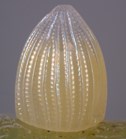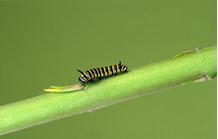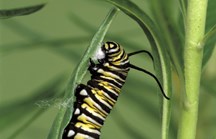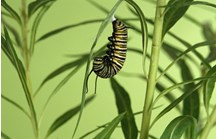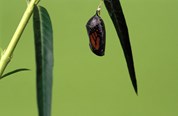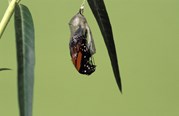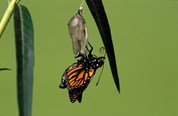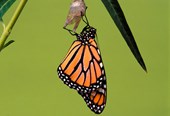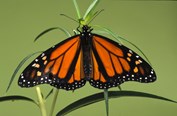Life cycles
The Wanderer Butterfly's life cycle, like all moths and butterflies, involves undergoing metamorphosis.
The female butterfly lays an egg and the larva or caterpillar hatches out of the egg within two to three days. The newly hatched caterpillar eats its own egg and then eats leaves to get energy to grow.
The caterpillar grows and moults many times, and after about three to four weeks it begins to pupate. To do this, the caterpillar attaches itself to a branch with a button of silk, hangs upside down and its chrysalis forms after its final moult of caterpillar skin.
After ten days of pupation inside the chrysalis it emerges as an adult butterfly. As an adult, it drinks nectar from flowers using its long tube-like tongue called a proboscis. From the nectar it gets energy to fly, reproduce and lay eggs for another generation.
The image gallery below shows the Wanderer Butterfly growing and changing as it starts life inside an egg, hatches out as a caterpillar, and finally metamorphosises into a butterfly.
Learning outcomes
In this activity children will:
- explore the different stages of the life cycle of a butterfly
- make observations, describe changes and ask questions about the butterfly's life cycle
- respond to questions about the butterfly's life cycle.
Engage
- What can you see in the pictures?
- What do you think is happening?
- Have you ever seen butterflies or caterpillars in your schoolyard or backyard?
Explore
- Is it the same animal, from caterpillar to butterfly?
- A caterpillar eats leaves while the adult – the butterfly – drinks nectar. Why do you think they might eat different food?
- What questions do students have about the life cycle of butterfly?
Explain
Living things grow, change and have offspring similar to themselves. But in the case of a butterfly the young look very different to the adults. As caterpillars, they crawl, eat and grow. They are not able to reproduce or move great distances. As butterflies, they drink nectar, move by flying and can reproduce. Since the young eat and live differently to the adults they are not competing for the same food or places to live.
Elaborate
- Have each student write down one question they have about butterfly life cycles based on the images. Place the students' questions on a 'wonder wall', and use them to guide the direction of the unit.
- Have the students write a story or act out in a role play the life cycle of a butterfly.
- Go outside and look for caterpillars or butterflies in the school yard. See if you can find out what they are, or take photographs of your own.
- Ask children to bring in a photo of themselves as a baby, and compare themselves and their changes in their life cycle so far to those of a butterfly. Create a Venn diagram in which you could work out what is the same about their life cycle to a butterfly and what is different.
Evaluate students' understanding
- Each day, have the students write a paragraph about what they learnt about life cycles.
- Have the students draw their own example of the stages of the butterfly life cycle, including new scientific vocabulary.
- Each student could make a digital story about their own life cycle compared with other animal life cycles.
